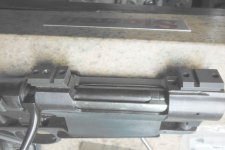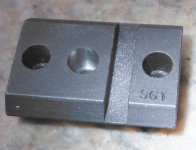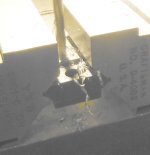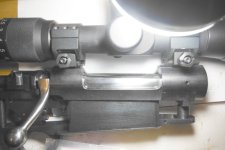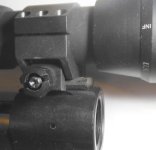You are using an out of date browser. It may not display this or other websites correctly.
You should upgrade or use an alternative browser.
You should upgrade or use an alternative browser.
Receiver Opinions Please
- Thread starter CowTowner
- Start date
Cow, you are on my short list.
I ordered (24) [some extra] of Weaver S61 flat bottom .860" steel mounts.
All I have to do is, in half of them, drill and countersunk hole and shorten the base. I won't have to do anything to the front base.
With a stop on the mill vise, it will take just seconds extra to make extra rear bases:
1) center drill at .504" a batch in the mill
2) through hole drill a batch in the mill
3) countersink with 7/32 end mill, a batch in the mill
4) mill the end off a batch in the mill
5) deburr the cut offs with a file
6) blue cut off end and countersunk holes with some boiling water
It all seems easy in the planning state.
I ordered (24) [some extra] of Weaver S61 flat bottom .860" steel mounts.
All I have to do is, in half of them, drill and countersunk hole and shorten the base. I won't have to do anything to the front base.
With a stop on the mill vise, it will take just seconds extra to make extra rear bases:
1) center drill at .504" a batch in the mill
2) through hole drill a batch in the mill
3) countersink with 7/32 end mill, a batch in the mill
4) mill the end off a batch in the mill
5) deburr the cut offs with a file
6) blue cut off end and countersunk holes with some boiling water
It all seems easy in the planning state.
I did not get my order of bases from SWAFA yet, but I snagged a couple new old stock off Ebay.
These are simply flat bottomed Weaver grand slam steel bases, S61.
The one in front fits with 0.860" centers.
The one in the rear I drilled an extra #26 hole on 0.504" centers, and made a 7/32" countersink 0.245" deep.
These are simply flat bottomed Weaver grand slam steel bases, S61.
The one in front fits with 0.860" centers.
The one in the rear I drilled an extra #26 hole on 0.504" centers, and made a 7/32" countersink 0.245" deep.
Attachments
I know I'm a little late to the party but this action has been discussed in length on other forums. Here is a post from a guy who used Sunny Hill rings to mount his scope.
TC1 said:I did a nice little custom with one of those actions years ago. Rings for these actions are indeed very rare. They have a pin on the bottom base of the ring and an indention is milled in front bridge of the action to keep the scope from moving under recoil. I was told Dumoulim would re-cut the bridges and fit proprietary rings. I finally .found a pair of mounts for the action at SunnyHill. I seriously doubt they still have any but it might be worth a try.
the action is a little rough around the edges, but one hell of a value.
Here is mine. .338-06
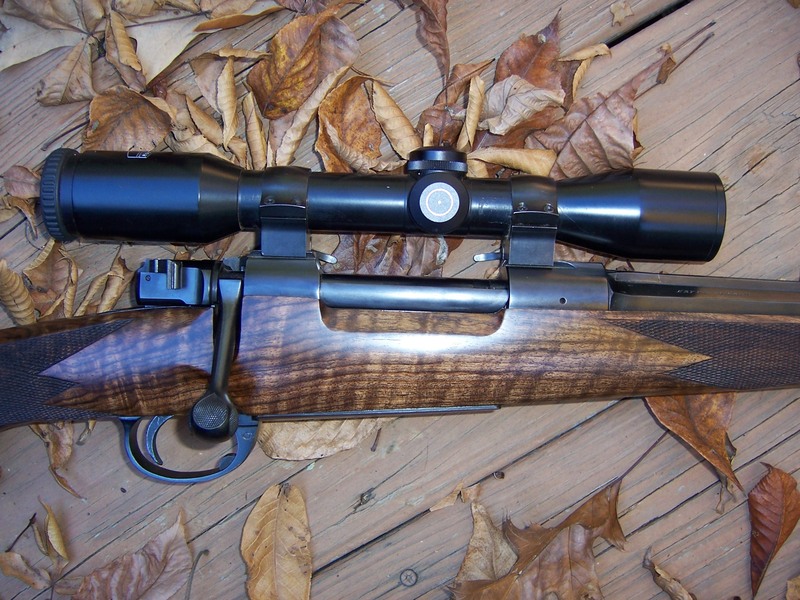
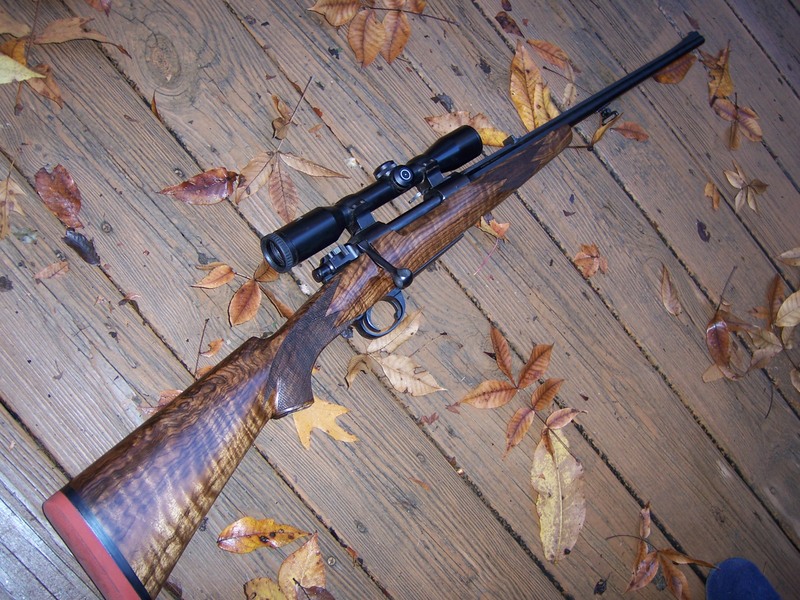
TC1 said:[color:#660000][font:Impact][size:20pt]FOR ANYBODY WANTING MOUNTS FOR THIS ACTION[/size][/font][/color]
I just called Sunny Hill manufacturing and they still have mounts (in stock) for this action. He told me they have both 30MM and 1" and will make more if there is a demand for them.
They are $210 for regular non-Q/D and $225 for Q/D plus $7 for shipping. A little pricey but a lot cheaper than EAW's and IMHO, better looking.
This is what I'm running on mine and had to order another pair while I had him on the phone
Here is the other side for those interested.
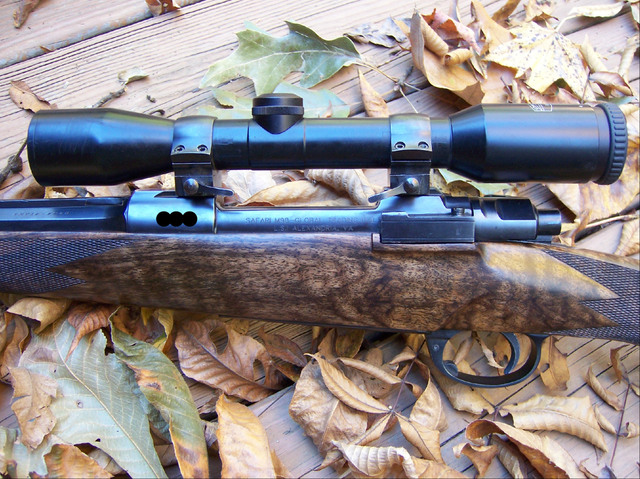
TC1 said:I have seen several examples of these milled to accept Talley mounts.
On the Sunny Hill mounts. They have them in stock. You just have to call and order. Prices and other info have already been posted in this thread.

Clark said:But I am getting steel Weaver bases for $22/rifle.
Clark my thing is you have the tools to mill the bridges, why don't you just make them accept Warne or Leupold QRW rings? To me that would be better than adding bases on the bridges which will elevate the scope even more.
Based on the picture Clark linked to of his setup, it doesn't appear to be too high. And, if one would choose a 50mm objective lens for the scope, it should fit quite nicely.
A stock with a slightly higher comb, like the Boyd's Prairie Hunter model, should handle the check rest as well.
A stock with a slightly higher comb, like the Boyd's Prairie Hunter model, should handle the check rest as well.
I have tried something new, despite the quantity of parts I have on back order.
The is an S54 and an S46 with the radius on the bottom milled off.
It gets this tactical 30mm ring and scope to be 1.75" from the bore line, which is usually the minimum.
The is an S54 and an S46 with the radius on the bottom milled off.
It gets this tactical 30mm ring and scope to be 1.75" from the bore line, which is usually the minimum.
Attachments
In these pics you can see the bottom getting milled off.
I had to file off the burr.
Filing off the burr put a nick in the parkerizing or what ever finish there is there. The up close pics looked terrible with the burr and worse with the hole in the finish. So I took a Marks a lot felt pen and covered over the shiny part. Looks great on camera now, but maybe bluing would be better for the real world.
I had to file off the burr.
Filing off the burr put a nick in the parkerizing or what ever finish there is there. The up close pics looked terrible with the burr and worse with the hole in the finish. So I took a Marks a lot felt pen and covered over the shiny part. Looks great on camera now, but maybe bluing would be better for the real world.
Attachments
-
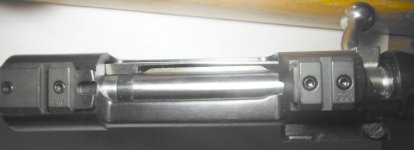 Dumoulin Mauser with S46 adn S54 bases modified c 12-2-2014.jpg40.5 KB · Views: 71
Dumoulin Mauser with S46 adn S54 bases modified c 12-2-2014.jpg40.5 KB · Views: 71 -
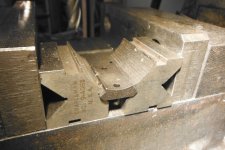 mill off the radius on the bottom of a Weaver S46 for the Dumoulin Mauser base 12-2-2014.jpg114.7 KB · Views: 66
mill off the radius on the bottom of a Weaver S46 for the Dumoulin Mauser base 12-2-2014.jpg114.7 KB · Views: 66 -
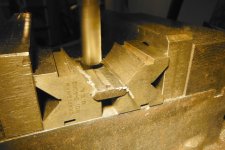 mill off the radius on the bottom of a Weaver S46 for the Dumoulin Mauser base b 12-2-2014.jpg120.6 KB · Views: 69
mill off the radius on the bottom of a Weaver S46 for the Dumoulin Mauser base b 12-2-2014.jpg120.6 KB · Views: 69
That's certainly the "KISS" principle. I've always been a proponent of the Weaver/picatinny mounting system. With "traditional" ring mounts, you have zero flexibility- can't change ring heights, can't change 1"/30mm... I would never own anything else.
Forgive the question from the learning novice machinist Clark...
If I were going to do what you did, I would have indicated the rail sections in the milling vise (level), and just milled off the tops. Is the dovetail jig required to prevent the rail sections from "slipping" when milling- IOW- pressure from square vise jaws on the edges might not be sufficient?
Forgive the question from the learning novice machinist Clark...
If I were going to do what you did, I would have indicated the rail sections in the milling vise (level), and just milled off the tops. Is the dovetail jig required to prevent the rail sections from "slipping" when milling- IOW- pressure from square vise jaws on the edges might not be sufficient?
I don't know of any Picatinny rails entering and winning beauty contests. They are winners in the functionality the have. The first ones were called a "Davis" rail as gunsmith Jack Davis made them in the early 1960's. Nothing is better for scopes mounted to allow all of their adjustment range to be used and put scopes far enough from aiming eyes in positions other than standing.
Bart,
6 or 8 years ago I was at an aerospace contract job where I got a cubicle and a bench in the lab... standard gig.
On the bench next to me was a long term small research contract with testing at Fort Picatinny for black powder side thruster course correction of missiles [cheaper than an air vane]. The system had an 8x32x44 Burris signature scope attached on top. The cubic yard fixture was sent back and forth to the fort. How was the scope mounted to the fixture? Not with a Picatinny rail, it was a Weaver rail
6 or 8 years ago I was at an aerospace contract job where I got a cubicle and a bench in the lab... standard gig.
On the bench next to me was a long term small research contract with testing at Fort Picatinny for black powder side thruster course correction of missiles [cheaper than an air vane]. The system had an 8x32x44 Burris signature scope attached on top. The cubic yard fixture was sent back and forth to the fort. How was the scope mounted to the fixture? Not with a Picatinny rail, it was a Weaver rail
Clark, that rings a small bell; I may have heard about that once up on a time. But I thought it was Lake City's facility that did it.
One interesting thing about scope bases is no maker has made a set of them to do the same thing an angled rail does. They have this thing about having to mount scopes so only about half their elevation adjustment range can be used but all of it's windage. The opposite's the best application for firearms.
One interesting thing about scope bases is no maker has made a set of them to do the same thing an angled rail does. They have this thing about having to mount scopes so only about half their elevation adjustment range can be used but all of it's windage. The opposite's the best application for firearms.
Bart,
The angular vertical adjustment of low power scopes is huge, and they don't need it.
The angular vertical adjustment of high power scopes is small, and they need more.
When one moves the cross hairs with a turret, the image moves, and the shooters head moves to follow it.
But pellet gun youtube channel "Ted's HoldOver" shows starlings being shot with a video camera attached to the scope eyepiece. There is no head to move. If he adjusted a turret the camera would loose sight of the image. So he has to use a graduated reticle or adjustable rings, as he explains at 7:43 into his last:
https://www.youtube.com/watch?v=XIklqgXi05A
I don't make great vids like Ted, but this one is only 12 seconds long
https://www.youtube.com/watch?v=KJXO8kaXfJI
To make that vid, I put the camera on a rack and pinion mechanism scrapped out of a big microscope. With the microscope knobs I can adjust the camera until it finds that little exit pupil image. I can only slightly adjust the turrets, or the image will disappear.
The angular vertical adjustment of low power scopes is huge, and they don't need it.
The angular vertical adjustment of high power scopes is small, and they need more.
When one moves the cross hairs with a turret, the image moves, and the shooters head moves to follow it.
But pellet gun youtube channel "Ted's HoldOver" shows starlings being shot with a video camera attached to the scope eyepiece. There is no head to move. If he adjusted a turret the camera would loose sight of the image. So he has to use a graduated reticle or adjustable rings, as he explains at 7:43 into his last:
https://www.youtube.com/watch?v=XIklqgXi05A
I don't make great vids like Ted, but this one is only 12 seconds long
https://www.youtube.com/watch?v=KJXO8kaXfJI
To make that vid, I put the camera on a rack and pinion mechanism scrapped out of a big microscope. With the microscope knobs I can adjust the camera until it finds that little exit pupil image. I can only slightly adjust the turrets, or the image will disappear.
Clark, all my scopes are rear focal plane. The crosshairs are fixed at the back end behind the erector tube. Making adjustments moves the erector tube's front end pointing at different places focussing on the fixed image made by the fixed objective lens. That moved the target image around the reticule where it's focused. As the eyepiece is also fixed in place focussing on the reticule and the inverted target image focused in the same plane, my aiming eye stays in the same place as adjustments are made. The reticule - eyepiecelens axis is fixed and never moves; only the target image plane moves on the reticule.
My aiming eye's at the same place for a shooting bore sight to a 1000 yard zero 46 MOA above it. Shooting bore sight is a 100 yard zero minus the sum of bullet drop plus sight height above bore. That's where I set my sights mechanical zeros at. It's never where the bore axis is.
My aiming eye's at the same place for a shooting bore sight to a 1000 yard zero 46 MOA above it. Shooting bore sight is a 100 yard zero minus the sum of bullet drop plus sight height above bore. That's where I set my sights mechanical zeros at. It's never where the bore axis is.
Last edited:

